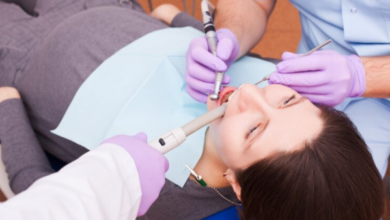The World of Dental Bridges: A Comprehensive Guide

1. Introduction to Dental Bridges
In the dynamic field of restorative dentistry, repairing dental bridges emerges as an essential solution to address the challenges posed by missing teeth. These prosthetic wonders seamlessly fill the gaps, offering not just functional benefits but a renewed sense of confidence and oral well-being. As we embark on a comprehensive journey through the intricate world of dental bridges, it’s crucial to recognize their multifaceted impact on individuals seeking a complete and vibrant smile. The transformative possibilities they bring extend beyond aesthetics, encompassing improved speech, enhanced chewing ability, and the prevention of dental misalignments that may arise in the absence of a comprehensive tooth structure. In essence, dental bridges not only restore smiles but contribute to the overall health and harmonious functioning of the oral cavity.
2. Types of Dental Bridges
Dental bridges, much like the diverse needs of patients, come in a spectrum of types, each finely tuned to specific requirements. Traditional bridges, a common choice, involve crafting crowns for adjacent natural teeth, with artificial teeth skillfully bridging the gap. Cantilever bridges and Maryland-bonded bridges offer alternative solutions, showcasing the versatility within restorative dentistry.
When considering dental bridges, it’s essential to understand the nuanced characteristics of each type. Traditional bridges, anchored by adjacent natural teeth, provide stability and durability, making them suitable for various cases of tooth loss. On the other hand, Cantilever bridges, designed for situations with only one adjacent tooth, offer a unique solution, redistributing forces efficiently. Maryland-bonded bridges, known for their minimal tooth alteration, are an excellent choice when preserving the structure of adjacent teeth is a priority. This diversity in bridge types not only caters to individual preferences but also ensures that patients receive customized solutions tailored to their specific oral conditions.
3. The Importance of Dental Bridges
Beyond the evident aesthetic enhancements, dental bridges play a pivotal role in preserving overall oral health. Unaddressed gaps can lead to a cascade of issues, including misalignment, speech impediments, and potential jaw joint complications. Dental bridges, acting as sturdy guardians, not only restore stability and proper bite alignment but also act as preventatives against the shifting of surrounding teeth.
Moreover, the significance of dental bridges extends beyond the visible restoration of a complete smile. These prosthetic marvels contribute to maintaining the integrity of the entire oral structure. The absence of a bridge in a gap can trigger adjacent teeth to shift, leading to potential misalignments that may affect not only aesthetics but also functional aspects of chewing and speech. By bridging the gaps left by missing teeth, dental bridges ensure the harmonious alignment of teeth, preventing the onset of more profound dental issues and promoting optimal oral well-being.
4. Candidacy for Dental Bridges
Determining eligibility for dental bridges requires a nuanced examination by a family dentist in San Jose. Factors such as the general state of oral health, the condition of adjacent teeth, and the patient’s commitment to post-treatment care influence the candidacy process. This personalized approach ensures that the treatment aligns seamlessly with individual needs and expectations.
5. The Dental Bridge Placement Process
Starting on the journey toward a revitalized smile involves a meticulous process orchestrated by dental experts. From the initial comprehensive examination to the precision of treatment planning, each step contributes to the success of the dental bridge placement. Impressions, temporary fittings, and the final customization ensure a seamless fit and a confident smile restoration.
In the initial phase, the dental team conducts a thorough examination, assessing the condition of existing teeth and overall oral health. This comprehensive evaluation guides the development of a personalized treatment plan tailored to the unique needs of the patient. Following this, impressions of the teeth are taken, providing a precise mold for the creation of the dental bridge. Temporary fittings allow patients to experience the feel of the bridge before the final placement, ensuring comfort and satisfaction with the restoration. The final customization involves fine-tuning the bridge for an impeccable fit, aligning with the patient’s natural bite and aesthetics, and ultimately delivering a seamlessly integrated and confident smile restoration.
6. Pros and Cons of Dental Bridges
While the advantages of dental bridges are substantial, it’s imperative to weigh them against potential considerations. Enhanced aesthetics, restored functionality, and the prevention of adjacent teeth shifting are notable pros. However, aspects such as the necessity of altering adjacent teeth, long-term maintenance considerations, and the associated costs should be thoughtfully evaluated.
7. Caring for Dental Bridges
The journey towards enduring oral health with dental bridges demands a commitment to meticulous oral hygiene. Establishing consistent oral care routines, such as regular brushing with a soft-bristled toothbrush and using floss or interdental brushes, becomes fundamental in preserving the bridge’s integrity. Incorporating scheduled professional cleanings into the oral care regimen provides a comprehensive approach to maintaining optimal oral health and the longevity of the dental bridge.
Moreover, avoiding sticky or hard foods is not only beneficial for general oral health but adds an extra layer of protection specifically for the durability of the bridge. By steering clear of these types of foods, patients contribute to preventing potential damage or dislodgment of the bridge, ensuring its continued functionality and aesthetic appeal. This commitment to preventive care and mindful dietary choices becomes paramount in safeguarding the investment made in the dental bridge and promoting long-term oral well-being.
8. Potential Complications and Solutions
While dental bridges boast reliability, occasional complications may arise. Decay, gum disease, or even bridge detachment can be addressed through regular dental check-ups. Early detection allows for minor adjustments or, in more severe cases, timely solutions such as bridge replacement, ensuring the sustained effectiveness of the restorative treatment.
9. Cost Considerations and Insurance
Navigating the financial aspect of dental bridges involves understanding the variables influencing the cost. The type of bridge and materials used contribute to the overall expenses. Dental insurance coverage may alleviate a portion of the financial burden, and exploring available financing options can further facilitate access to this valuable restorative procedure.
10. Dental Bridges vs. Alternative Options
Exploring alternatives to dental bridges, such as dental implants or removable partial dentures, is a crucial step in making informed decisions about tooth replacement. Understanding the nuanced benefits and drawbacks of each option empowers patients to align their choices with their unique oral health aspirations.
Conclusion
In conclusion, dental bridges emerge as not just interventions but transformative experiences, breathing new life into smiles and enhancing oral well-being. With advancements in dental technology and the expertise of dental professionals, individuals can embark on a journey towards not only functional restoration but also the enduring brilliance of a confident and radiant smile. If dental bridges are on your radar, consulting with a dental professional ensures a personalized path toward a healthier and more beautiful smile.
Read More: India Royale Before Surgery




